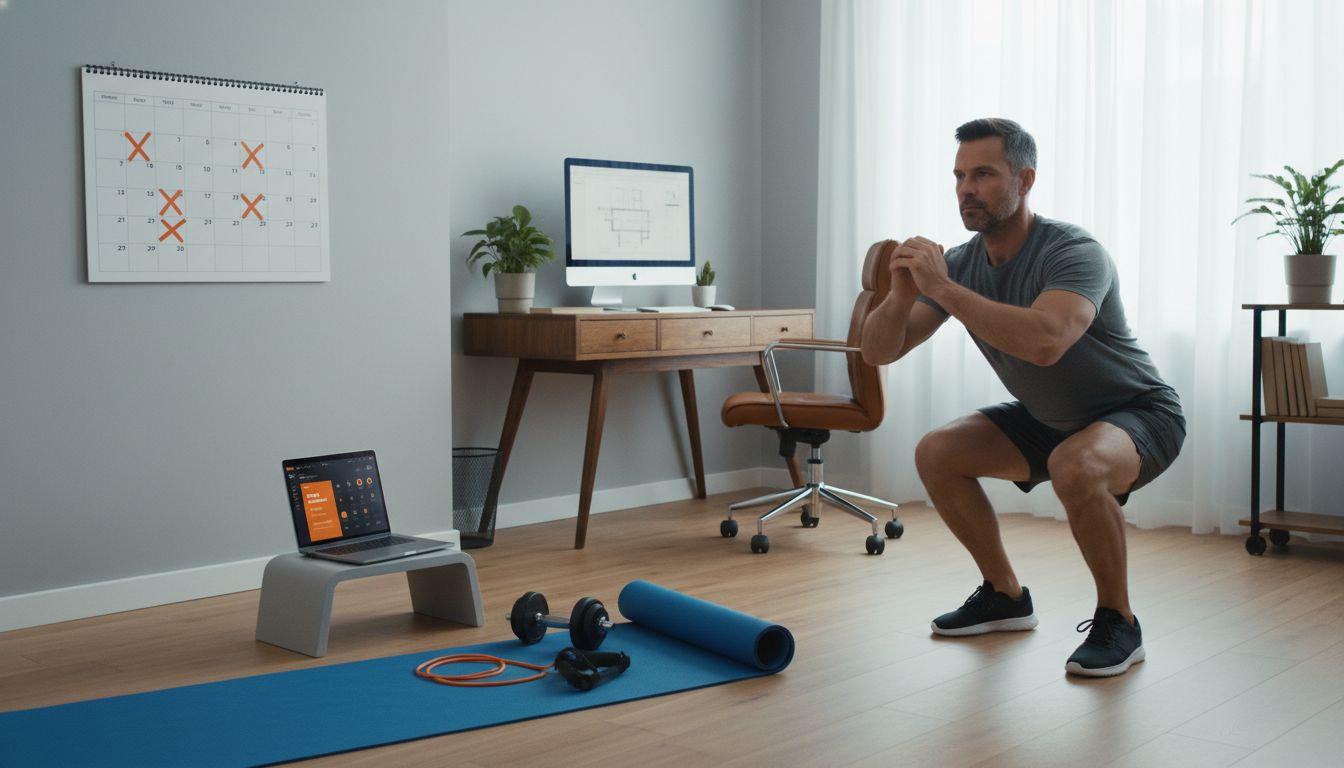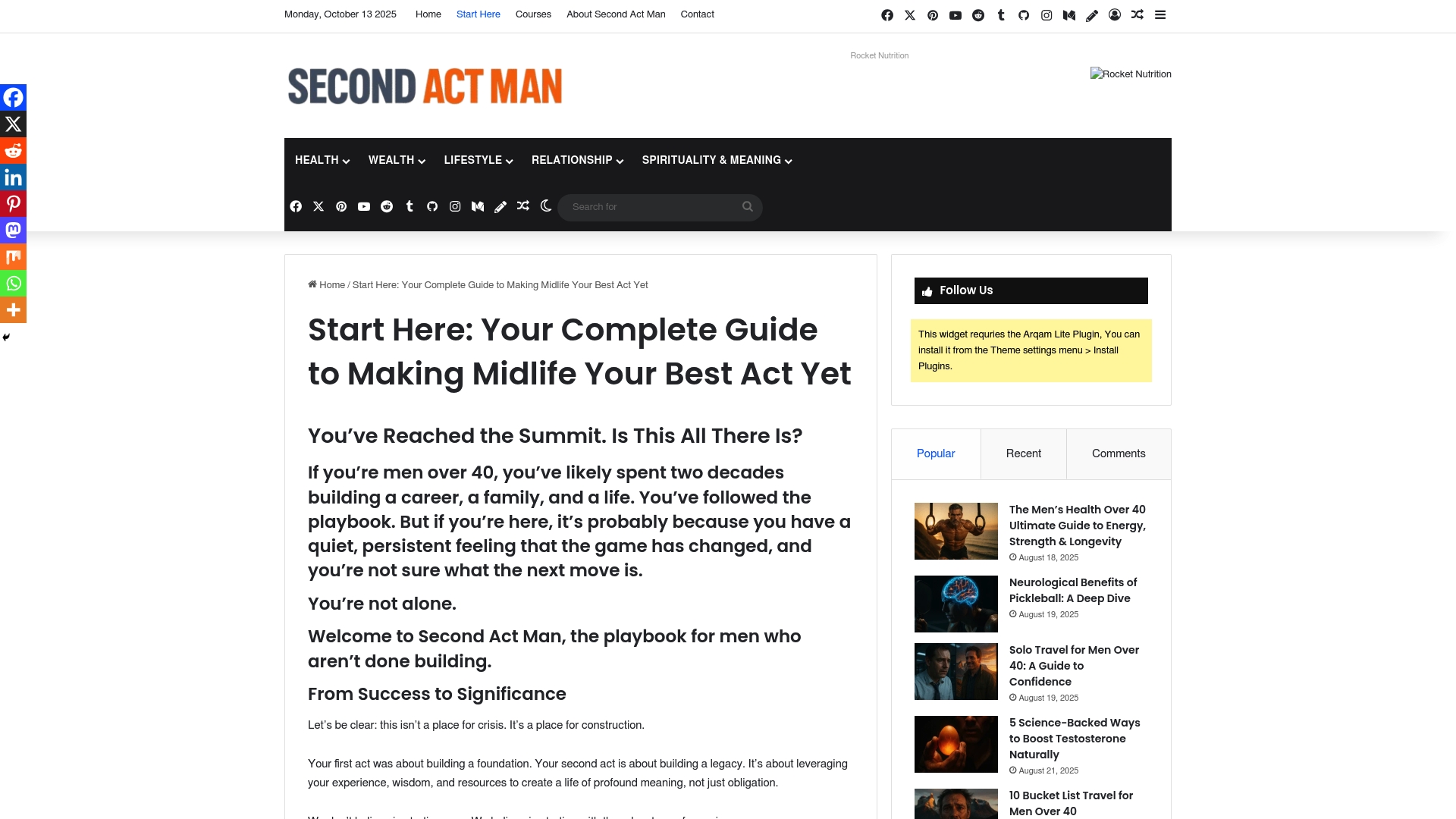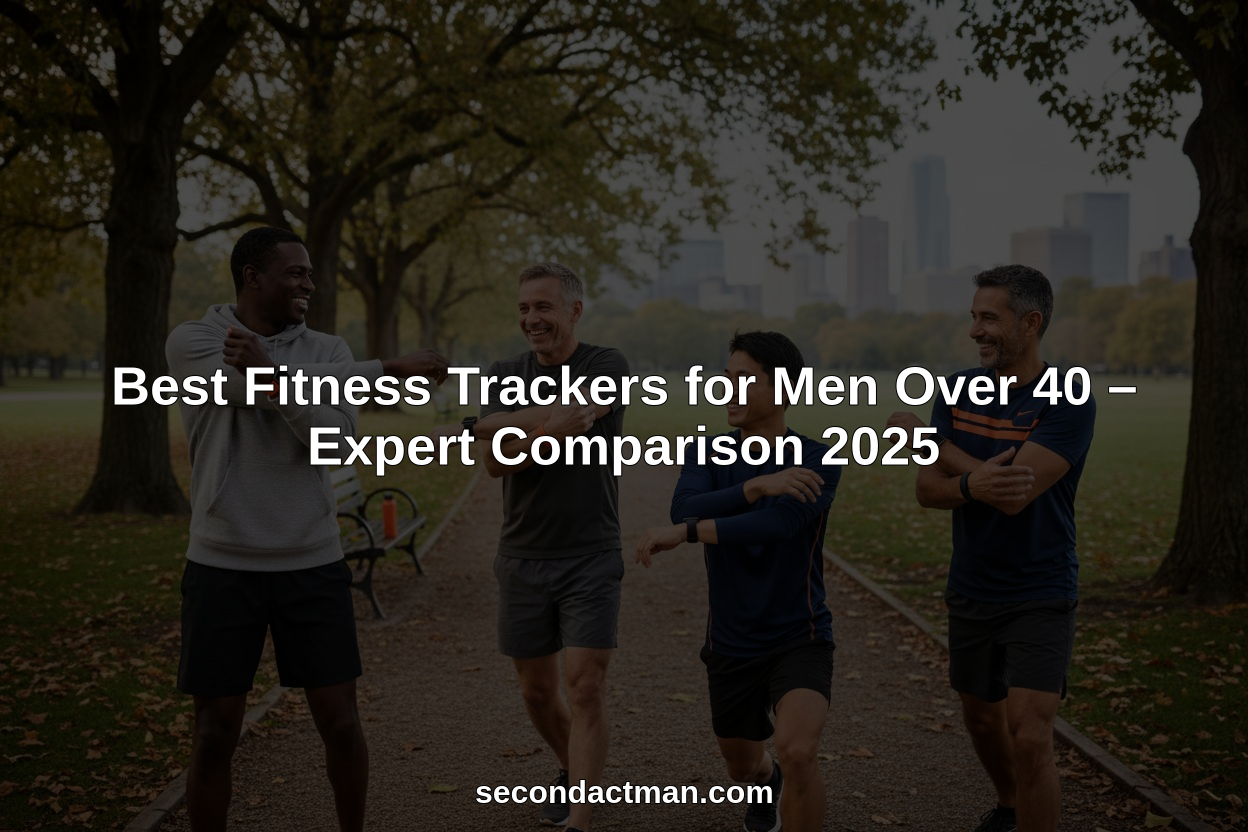Step by Step Fitness Transformation Over 40 for Men

Did you know that men over 40 who track their fitness from day one are 78 percent more likely to see real, lasting results? As age changes your metabolism and energy, building a stronger body requires a clear game plan. By assessing your true starting point and setting real goals, you set the stage for steady progress and renewed confidence in every part of your life.
Table of Contents
- Step 1: Assess Your Starting Point And Set Clear Goals
- Step 2: Design A Realistic And Sustainable Fitness Plan
- Step 3: Optimize Nutrition And Track Daily Progress
- Step 4: Incorporate Strength And Flexibility Training
- Step 5: Monitor Results And Adjust Your Approach
Quick Summary
| Key Point | Explanation |
|---|---|
| 1. Assess Your Starting Point Honestly | Conduct a personal fitness audit to understand your current health metrics and set a clear baseline for progress. |
| 2. Set SMART Goals | Establish specific, measurable, achievable, relevant, and time-bound objectives for your fitness journey. |
| 3. Create a Sustainable Fitness Plan | Develop an exercise routine that fits your lifestyle, mixing strength, cardio, and flexibility training to stay engaged. |
| 4. Monitor Nutrition Diligently | Track your daily nutrition and adjust macronutrient intake to support energy and muscle recovery as you age. |
| 5. Regularly Review and Adjust | Consistently monitor your progress and adapt your fitness plan based on your results and physical responses. |
Step 1: Assess Your Starting Point and Set Clear Goals
Welcome to the most important foundational step of your fitness transformation. Before you start lifting weights or running miles, you need an honest snapshot of where you currently stand. According to research from the National Institutes of Health, men over 40 who conduct a comprehensive personal fitness assessment are 78% more likely to achieve sustainable health improvements.
Start by conducting a personal fitness audit. This means measuring your current body composition, cardiovascular endurance, strength levels, and flexibility. Get a professional body composition test that calculates your body fat percentage, muscle mass, and metabolic rate. These metrics provide a clear baseline for tracking your progress.
Next, perform some basic fitness tests that reveal your current capabilities. Can you do 10 pushups with proper form? How long can you walk or jog continuously? What is your resting heart rate? Document these initial measurements in a notebook or digital tracker. According to a study on male amateur cyclists aged 40 to 60, tracking these baseline metrics is crucial for setting realistic fitness objectives.
Here’s a summary of key fitness assessments to get started:
| Assessment Area | What to Measure | Recommended Method |
|---|---|---|
| Body Composition | Body fat %, muscle mass | Professional analysis Home scale with sensors |
| Cardiovascular Endurance | Time to walk/jog Resting heart rate | Timed walk/jog test Heart rate monitor |
| Strength Levels | Pushups, squats, rows | Max reps with good form |
| Flexibility | Hamstring reach Shoulder mobility | Sit-and-reach test Arm reach test |
Pro Tip: Be brutally honest with yourself during this assessment. Your starting point is not a judgment but a launching pad for transformation.
Set 3 types of goals that work together: performance goals (like completing a 5K run), process goals (exercising 4 times per week), and outcome goals (losing 15 pounds of body fat). Make these goals specific, measurable, and time-bound. An effective goal might look like: “I will reduce my body fat percentage from 28% to 20% in 6 months by strength training 3 times and doing cardio 2 times per week.”
Remember that this initial assessment is not about comparing yourself to others but understanding your unique starting point. Every fitness journey is personal, and your path will look different from anyone else’s. Stay patient, stay curious, and most importantly, stay committed.
Are you ready to map out your personal fitness transformation blueprint?
Step 2: Design a Realistic and Sustainable Fitness Plan
Now that you understand your starting point, it is time to craft a fitness strategy that fits your life and keeps you motivated. Research on male amateur cyclists demonstrates that creating a sustainable exercise regimen is key to mitigating age-related fitness declines and maintaining long-term health momentum.
The foundation of a realistic plan starts with understanding your personal constraints and opportunities. Consider your work schedule, family commitments, and current energy levels. Do not aim for an extreme workout routine that you cannot maintain. Instead, design a plan that integrates seamlessly into your lifestyle. Check out our guide on home gym equipment to help you create convenient workout spaces that fit your schedule.
A balanced approach means mixing different types of exercise to keep your body challenged and engaged. Aim for a combination of strength training, cardiovascular exercise, and flexibility work. For men over 40, this might look like 2 to 3 strength sessions per week, 2 to 3 cardio sessions, and regular stretching or yoga to maintain mobility.
Pro Tip: Start small and build consistency. Better to do 20 minutes of exercise 4 times a week than burn out trying to do 2-hour marathon sessions.
Research indicates that engaging in physical activities aligned with personal interests significantly improves long-term adherence. If you hate running, do not force yourself onto a treadmill. Maybe you enjoy cycling, swimming, or martial arts. Choose activities that genuinely excite you and make you feel strong.
Schedule your workouts like important business meetings. Block time in your calendar, prepare your gear in advance, and treat these fitness appointments with the same commitment you would give to a critical work project. Consistency trumps intensity every single time.

Are you ready to transform your approach to fitness and design a plan that works for your life?
Step 3: Optimize Nutrition and Track Daily Progress
Nutrition becomes the secret weapon in your fitness transformation after 40. Research comparing older and younger men during extreme endurance exercise reveals that targeted nutritional strategies are critical for addressing age specific metabolic changes and achieving optimal performance.
Start by understanding your unique nutritional needs. Your metabolism is different now compared to your 30s. You need a balanced approach that supports muscle maintenance, energy production, and recovery. Explore our comprehensive nutrition guide for men over 40 to develop a personalized eating strategy that fuels your fitness goals.
Track your daily nutrition with precision. Use a digital food diary or app to log your meals, monitoring macronutrient ratios protein, carbohydrates, and healthy fats. Aim for a protein intake of 1.2 to 1.6 grams per kilogram of body weight to support muscle preservation and growth. Include lean proteins like chicken, fish, legumes, and consider high quality protein supplements that support muscle recovery.
Pro Tip: Timing matters. Consume protein within 30 minutes after your workout to maximize muscle protein synthesis and recovery.
Progress tracking goes beyond just stepping on a scale. Take weekly measurements of your body composition, track your workout performance, and note your energy levels. Research indicates that consistent monitoring is associated with decreased body fat and increased peak power output. Photograph yourself monthly from multiple angles to visually document your transformation.
Stay hydrated and consider strategic supplementation. Multivitamins, omega 3 fatty acids, and vitamin D can support your overall health and fitness journey. Remember that supplements are not magic pills but supportive tools in your nutrition arsenal.
Are you prepared to turn your nutrition into a powerful catalyst for your fitness transformation?
Step 4: Incorporate Strength and Flexibility Training
This is where you transform from just losing weight to building a powerful, resilient body. Research on male amateur cyclists demonstrates that regular strength and flexibility training can effectively counter age related fitness declines and help you redefine your physical identity.
Strength training becomes crucial after 40. Your muscle mass naturally decreases about 3 to 5 percent per decade, but strategic resistance training can dramatically slow this process. Check out our guide on home gym equipment to help you set up an effective home workout space that supports your strength goals.
Start with compound movements that engage multiple muscle groups. Exercises like squats, deadlifts, push ups, and rows will give you maximum return on investment. Begin with bodyweight versions if you are new to strength training, then progressively add weights as you build confidence and technique.
Pro Tip: Focus on proper form over lifting heavy weights. Quality repetitions prevent injury and build genuine strength.
Flexibility training is not optional it is essential. Incorporate dynamic stretching before workouts and static stretching afterward. Yoga or mobility work 2 to 3 times per week can improve joint health, reduce injury risk, and enhance overall movement quality. Research indicates that diverse physical activities can significantly improve older men’s well being and physical performance.
Consider your recovery as seriously as your workout. Alternate muscle groups, allow 48 hours between strength sessions for the same muscle group, and listen to your body. Some days you will feel strong, other days you might need lighter activity. Adaptability is your greatest fitness asset.
Are you ready to build strength that defies your age and flexibility that keeps you moving like a much younger man?
Step 5: Monitor Results and Adjust Your Approach
This is where most fitness journeys either flourish or fade. Research on male amateur cyclists highlights that consistent monitoring and strategic adjustments are the secret ingredients to long-term fitness success. Your body is a dynamic system constantly responding to your training and nutrition.
Explore our comprehensive nutrition guide for men over 40 to understand how tracking metrics can transform your fitness approach. Start by establishing a consistent assessment routine. Every 4 to 6 weeks, conduct a comprehensive progress check that goes beyond just weight measurements.
Track multiple metrics to get a holistic view of your transformation. Measure body composition, take progress photos, record strength improvements, and assess your cardiovascular endurance. Note not just physical changes but also energy levels, sleep quality, and overall mood. These subjective indicators are often more meaningful than numbers on a scale.
Pro Tip: Use a digital tracking app or notebook to log your measurements consistently. Trend lines reveal more than individual data points.
Be prepared to adjust your approach based on your results.
If you are not seeing desired progress, it does not mean failure it means you need strategic recalibration. Decrease workout intensity if you are feeling chronic fatigue. Increase protein intake if muscle recovery seems slow. Your fitness plan should be a living document that evolves with your body.
Remember that progress is rarely linear. Some weeks you will see dramatic changes, other weeks might feel stagnant. The key is persistence and intelligent adaptation. Research confirms that older men who regularly assess their physical activity can more effectively align their fitness plans with personal goals and capabilities.
Are you ready to become the architect of your own physical transformation?
Take Control of Your Fitness Transformation After 40 Today
Feeling overwhelmed by where to start or how to maintain your progress as you focus on fitness after 40 is common. This article clearly highlights the challenge of establishing a realistic, sustainable plan that balances strength, flexibility, nutrition, and progress monitoring. You want to rebuild your energy and confidence, slow down muscle loss, and finally see results that last without burnout or confusion.

Unlock practical strategies tailored just for men navigating this crucial phase by exploring our Fitness After 40 for Men: Workout Routines, Strength Training & Exercise Plans. You will find expert guidance on designing effective workouts and creating a schedule you can stick with. Combine this with insights from our Men’s Health Over 40: A Practical Guide to Fitness, Hormones & Vitality for holistic support that addresses more than just exercise. Don’t wait until frustration takes hold—start your transformation journey with confidence today at Second Act Man. Your next chapter deserves purposeful fitness and lasting renewal.
Frequently Asked Questions
How can I assess my current fitness level to start my transformation?
Begin by conducting a comprehensive personal fitness audit. Measure your body composition, cardiovascular endurance, strength levels, and flexibility to establish a clear baseline for your transformation journey.
What types of goals should I set for my fitness transformation over 40?
Set three types of goals: performance goals (like running a 5K), process goals (exercising four times a week), and outcome goals (losing 15 pounds). Make these goals specific, measurable, and time-bound to provide direction and motivation.
What should my fitness plan include for sustainable results?
Your fitness plan should include a balanced mix of strength training, cardiovascular exercise, and flexibility work. Aim for 2 to 3 sessions of strength training and cardio weekly, while also incorporating regular stretching or yoga for mobility.
How can nutrition impact my fitness transformation after 40?
Nutrition plays a vital role in your fitness journey by supporting muscle maintenance and energy production. Focus on a balanced diet that includes adequate protein, healthy fats, and carbohydrates to fuel your workouts and recovery.
How often should I monitor my progress during this transformation?
Conduct a comprehensive progress check every 4 to 6 weeks to track various metrics like body composition, strength, and endurance. Use this data to adjust your workout and nutrition plans based on your results and overall well-being.
What types of exercises should I focus on for strength training?
Focus on compound movements like squats, deadlifts, push-ups, and rows, as they engage multiple muscle groups and provide the most benefit. Start with bodyweight exercises, then gradually add weights as you build confidence and strength.







